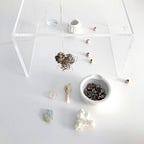Interview Excerpts | Studio Reflections
As I continue to update my art/design research site and writing materials from the archives, I have come across several studio interviews that still resonate with my practice. I wanted to share them as I transition to a new year, as certain ideas still remain valid, but also have evolved in new and expansive ways.
from recent dialogues/interviews regarding Walking Libraries:
“Walking Libraries (2016–2019) is an archive of handmade artifacts and found materials gathered and modified by environmental artist, Abigail Doan. This evolving materials library explores the documentation and language of site-specific phenomena in conjunction with observational and spatial notations. An ensuing kit of objects and tools is used to prompt further crafting initiatives in conjunction with atmospheric research and cultural investigations. Created as a movement arts research project with a social practice component, Walking Libraries has expanded into a visual lab experience that addresses the art of slow distillation as a means to preserve place.” — 2019
from Katrina’s Rodabaugh’s interview and online journal:
“I love that being an artist allows you to creatively weave together a life and travel in ways that inform or re-jigger what you deem to be true. I like to collect things, all sorts of things, primarily as a visual database of sorts but also as a humble cultural preservationist. The more I am able to let go of certain labels about what I do, what I make, and how I must share this work, the freer I am to do better work and perhaps reach a wider audience. I never take for granted that I have a unique and rather privileged opportunity to express what I want to make and also care about. I am not so fixated on the art object per se but rather its dematerialization into something new and hopefully broader in scope.” — A.D. 2016
from a VOZ woman interview and profile:
“I have always loved living with the things that I make and collect. (I find that I often have small revelations as I pass by certain objects when traveling from room-to-room at home.) My family and I like to populate our space with things that have historic and tactile resonance, and it is with this spirit that we have also raised our children. We never really child-proofed our home and always encouraged our twins to be curious about the forms that animate and populate our space. Some of these objects were made by family members, some by my own hands, and other artifacts were collected by my husband and I during our travels.” — A.D. 2016
from Leslie Santarina’s interview and studio visit for SF Girl By Bay’s Unexpected Guests:
“My work is centered around ideas that explore materials in a variety of contexts. This might include actual sculptural forms, drawings, collages, and prints, but also installations that juxtapose artifacts and objects in unexpected ways. My studio practice is definitely process-oriented, and I spend a lot of time simply collecting and documenting materials in order to explore the possible relationships between forms and surfaces.” — A.D. 2015
from an interview with Design and Culture by Ed:
“Slow for me is basically about cultivating a connection to place as well as an understanding of self in relation to the environment. Immersing ourselves in the art of slow (fashion) might allow for deeper connections, more efficient flow, as well as identification of softer tools for implementing change. Local wisdom is certainly part of this equation as well as increased sensitivity to the cultural experiences and conditions/talents of peoples globally.” — A.D. 2015
from Amy DuFault’s interview for the Brooklyn Fashion + Design Accelerator Journal at Pratt:
“Tumbleweed Colony proposes a new crossroad for natural dyes and community involvement via the cultivation of the wilder side of urban living. We live in an era where information overload and environmental shifts have us navigating realms that feel increasingly de-humanized and de-saturated. Fortunately, there are bold new indicators that sustainable solutions for environmental balance and regional biodiversity exist within the complexity of our urban networks and the soil of vacant plots.” — A.D. 2015
from an interview with NAU’s Thought Kitchen:
“Fiber has universal properties that connect us to cultures and regions in ways that are border defying and vibrant. My dialogue with artisans/designers in Bulgaria, Chile, Iran, Peru, and Turkey to name just a few locales, has been inherently rich and complex because of unique connections to place and the sharing of local knowledge. The historic transport of textiles and design of shelters in these regions often inspires ideas for nomadic and adaptable thinking — solutions that work seamlessly with the environment and the challenges of climate. This sensitivity is something that I believe should be cultivated as we search for better ways of interfacing with altered landscapes and shifting economies.” — A.D. 2013
from a profile on NOMAD-CHICs Swim:
“As an environmental fiber artist, I continually drift through loose strands of textiles and debris in the studio — navigating an endless sea of possibility with the desire to grab onto the edge of a sculpted form or composition that has lasting resonance. I am all the stronger for going against the tide while also adorning myself with the flotsam from an epic swim that I have grown to call life.” — A.D. 2013
[ featured materials + text © Abigail Doan studio ]
